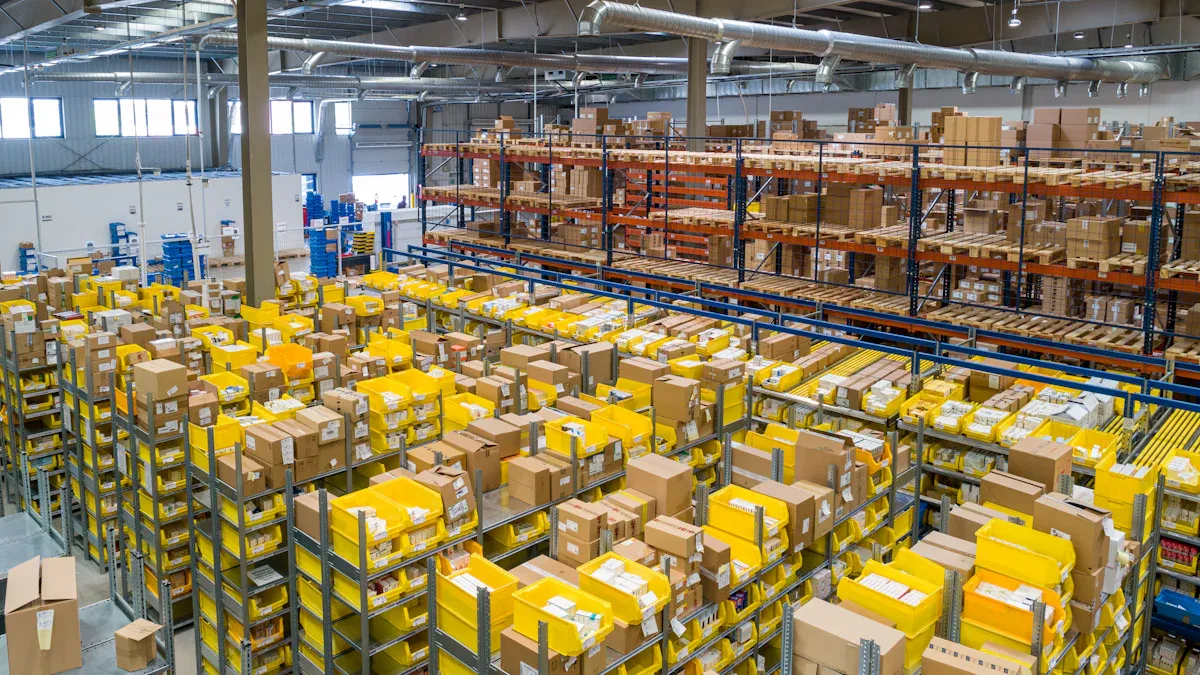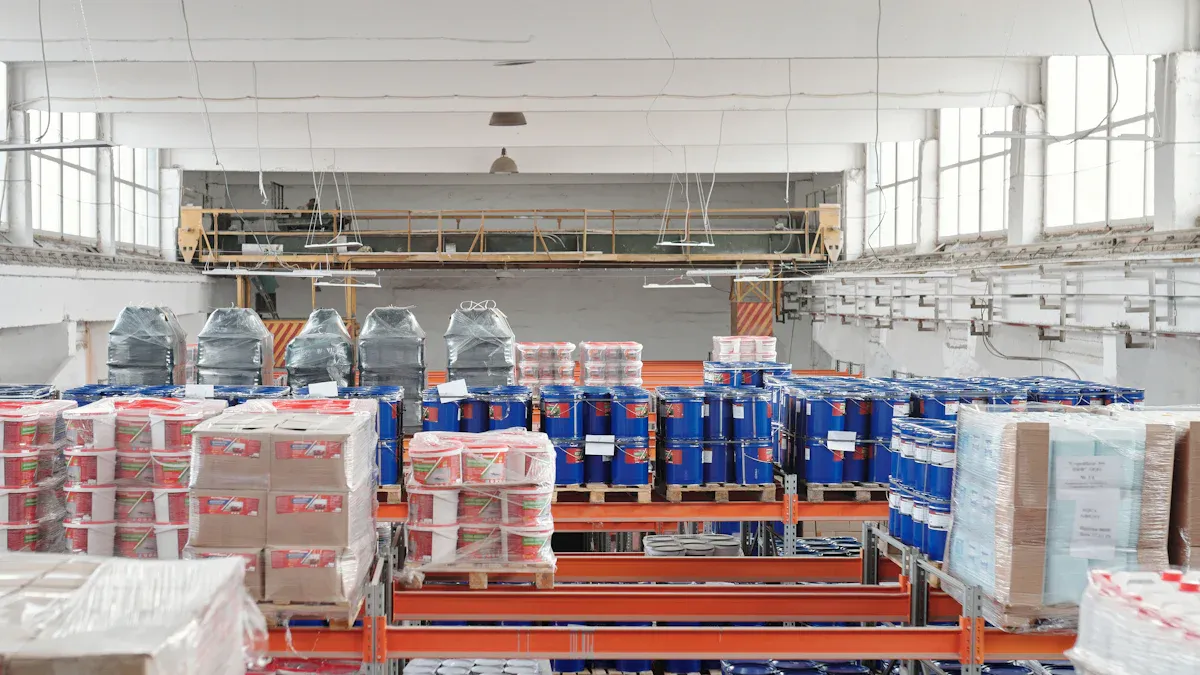Return Inventory Strategy: A Holistic Approach Beyond Traditional Warehouse Management

Traditional warehouse management often fails to address the complexity of product returns. Companies face unpredictable supply disruptions, variable production times, and changing customer demands, making a supply chain-wide Return Inventory Strategy essential. Industry data shows that 74% of businesses now invest in AI and analytics to improve efficiency, while sustainable practices like recycling and refurbishing help reduce waste and costs. Brands adopting integrated technology and reverse logistics see measurable improvements in profitability and customer satisfaction.
Key Takeaways
A holistic return inventory strategy manages returns across the entire supply chain to reduce waste, cut costs, and improve customer satisfaction.
Using technology like ERP, AI, and mobile apps helps companies track returns in real time, automate tasks, and make faster, smarter decisions.
Sustainable practices such as recycling and refurbishing returned products protect the environment and build customer trust.
Flexible return policies make customers feel confident and encourage repeat business and loyalty.
Regularly tracking key performance indicators (KPIs) helps companies spot problems, improve processes, and adapt quickly to market changes.
Strategy Overview
Return Inventory Strategy
A Return Inventory Strategy provides a structured approach for managing returned products across the entire supply chain. Companies that use this strategy move beyond basic warehouse operations. They focus on optimizing every step, from receiving returns to final disposition. This approach helps businesses reduce waste, control costs, and improve customer satisfaction.
Many organizations now use data-driven methods to guide their Return Inventory Strategy. For example, ABC analysis segments inventory by value and importance. High-value items receive more attention, while lower-value items require less oversight. This method helps companies prioritize resources and maintain healthy cash flow. Trend analysis also plays a key role. By studying past data, businesses can predict demand and adjust inventory levels. These techniques help prevent stockouts and reduce excess inventory.
Key performance indicators (KPIs) support the Return Inventory Strategy. Metrics such as inventory turnover, carrying cost, and on-time delivery allow companies to track progress. Regular monitoring of these KPIs leads to better decision-making and ongoing process improvement. Companies that implement holistic strategies see measurable results:
An automotive manufacturer achieved a 45% reduction in inventory levels and a 32% improvement in production efficiency.
A small electronics company reduced carrying costs by 38% and improved on-time delivery from 82% to 97%.
A regional beverage distributor cut waste by 65% and improved inventory turnover by 85%.
These outcomes show that a well-designed Return Inventory Strategy can transform inventory management and drive operational excellence.
Tip: Companies should review and update their inventory segments regularly. This ensures the strategy stays aligned with changing market conditions and customer needs.
Holistic Supply Chain View
A holistic supply chain view treats the entire supply chain as one connected system. This perspective helps companies identify bottlenecks and understand how each part affects the others. By looking at the big picture, businesses can make smarter decisions about returns and inventory.
Several industry benchmarks validate the benefits of this approach:
Key Metrics and Benchmarks | |
|---|---|
Productivity | Overall Equipment Effectiveness (OEE): 60-65% average, 85%+ world-class |
Quality | First Pass Yield: ≥95% |
Customer Return Rates: <1% | |
Defect Rate: <50 parts per million (PPM) | |
Inventory | Inventory Turnover: ~8.5 (industry average) |
Days of Supply: 5-10 days (raw materials) | |
Fill Rate: >98.5% (top performers) | |
Cost | Total Manufacturing Cost: <65% of revenue |
Labor Costs: 20-35% of Cost of Goods Sold (COGS) | |
Financial | Gross Margin: ~32% |
EBITDA: ~10% |
Companies that adopt a holistic supply chain view often achieve higher inventory turnover and better inventory accuracy. Techniques like cycle counting and real-time data tracking support these improvements. For example, Walmart and Procter & Gamble reduced stockouts by 15% through collaborative planning. West Marine and Levi Strauss cut inventory levels by 25% using similar methods. These results highlight the value of treating returns as part of the larger supply chain.
A holistic approach also addresses the financial impact of returns. Retailers face an average return rate of 16.5%, with returns causing up to 10% revenue loss. In B2B sales, returns can reach 30%. Despite this, only 6% of companies use a dedicated Returns Management System (RMS). Most rely on warehouse systems that lack robust returns features. An RMS provides end-to-end visibility, automates workflows, and supports sustainability goals. This system helps standardize returns management and optimize inventory handling across all channels.
Note: A holistic supply chain view enables companies to respond quickly to market changes. It also supports continuous improvement by providing clear metrics and real-time insights.
Key Challenges
Inefficiency
Many companies struggle with inefficiency in their return inventory processes. Manual tasks slow down operations and increase the risk of errors. Staff often spend time on low-value activities, such as searching for misplaced items or updating records by hand. These outdated methods lead to delays and higher labor costs. Automation tools exist, but many organizations do not use them fully. As a result, inventory changes from theft or breakage often go unrecorded, making planning and fulfillment more difficult. Companies that rely on legacy systems face even greater challenges, as these platforms rarely provide real-time updates needed for fast-moving supply chains.
Tip: Automating routine tasks can free up staff for higher-value work and improve overall efficiency.
Lack of Visibility
Visibility gaps create major obstacles in return inventory management. Fragmented data sources and siloed systems prevent teams from seeing the full picture. Without real-time SKU-level visibility, some locations hold excess stock while others face shortages. This imbalance disrupts supply chain flow and frustrates customers. Uncertainty in demand often leads to speculative ordering, which increases the risk of overstock and markdowns. Companies like Walmart have addressed these issues by using RFID technology. This approach enables accurate demand prediction, timely restocking, and better supplier collaboration. Real-time updates and analytics help teams respond quickly to changes and avoid costly mistakes.
Visibility gaps cause:
Overstock and stockouts
Missed demand opportunities
Delays and poor customer experiences
Lost sales and markdowns
Missed Value
Missed value often results from poor demand forecasting and reactive management. When companies cannot respond swiftly to market changes, they lose sales and face higher carrying costs. Inaccurate data leads to uninformed decisions about inventory allocation. Businesses that lack access to critical information often discount or write off products unnecessarily. Zara’s agile supply chain shows the benefits of real-time data. By producing smaller batches and responding quickly to trends, Zara minimizes overstock and reduces markdowns. Industry reports show that SKU-level visibility can reduce inventory holding costs by up to 40% and improve order fulfillment accuracy by 25%. Enhanced visibility and proactive management drive cost reduction, agility, and competitive advantage.
Technology Integration
ERP and FMS
Enterprise Resource Planning (ERP) and Fleet Management Systems (FMS) play a key role in modern return inventory strategies. These systems connect different parts of the supply chain, from warehouses to transportation. ERP platforms track products as they move through each stage. FMS tools monitor shipments and delivery routes. Together, they provide real-time updates on inventory levels and product locations. This visibility helps companies respond quickly to returns and avoid costly delays. Many businesses use ERP and FMS to automate routine tasks, such as restocking and order processing. This automation reduces errors and saves time for employees.
Tip: Companies that integrate ERP and FMS can spot problems early and make better decisions about inventory.
AI and Analytics
Artificial intelligence (AI) and analytics have changed how companies manage returns. AI-driven tools analyze large amounts of data to find patterns and predict future needs. For example, a leading e-commerce company used advanced analytics to improve demand forecasting by 20%. This improvement reduced excess inventory and eliminated stockouts. AI also helps with dynamic pricing. It monitors stock levels and expiration dates, then adjusts prices to reduce waste and boost sales. Retailers use AI-powered assistants and smart shelves to give instant inventory information. These tools help staff and customers find products faster.
A retail giant cut order fulfillment time by 50% using AI-powered solutions.
AI-driven analytics support omnichannel fulfillment, like buy-online-pickup-in-store (BOPIS), which reduces stockouts and improves customer satisfaction.
AI tools optimize inventory, making sure stores have the right products at the right time.
Phygital Solutions
Phygital solutions blend physical and digital experiences in inventory management. Smart shelves, RFID tags, and mobile apps connect the store floor with online systems. These tools give real-time updates on product availability. Shoppers can check stock on their phones or get help from in-store kiosks. Staff use handheld devices to scan returns and update records instantly. This approach bridges the gap between online and offline channels. Companies that use phygital solutions see faster returns processing and better customer experiences. Phygital tools also support sustainability by tracking products for recycling or refurbishment.
Reverse Logistics

Process Optimization
Companies improve reverse logistics by streamlining every step of the returns process. They use automation for sorting and inspection, which increases speed and accuracy. Barcode and RFID systems help track items and reduce mistakes. Many businesses now monitor key performance indicators (KPIs) to measure success. The table below shows common benchmarks and outcomes:
Performance Metric / KPI | Benchmark / Target | Process Improvement / Outcome |
|---|---|---|
Successful Resale/Recycling Rate | 75% - 85% | Automation boosts resale and recycling rates. |
Revenue Recovery from Resale | 20% - 40% of revenue | Refurbishment increases value and revenue recovery. |
Environmental Impact | 25% - 40% less waste | Eco-friendly recycling cuts waste and carbon footprint. |
Customer Satisfaction Score | ≥ 85% | Real-time feedback improves loyalty and satisfaction. |
Return Processing Time | < 48 hours | Faster processing lowers costs and improves satisfaction. |
Inspection Accuracy | > 95% | Technology reduces defective resales. |
Inventory Accuracy | ~95% - 98% | Better tracking improves efficiency. |
Companies that review KPIs regularly can reduce return-related costs by over 15% and improve efficiency by up to 20%. These gains support a strong Return Inventory Strategy.
Omni-Channel Returns
Omni-channel returns allow customers to return products through multiple channels, such as stores, online, or pickup points. This flexibility improves customer satisfaction and loyalty. Businesses use flexible reverse logistics networks to handle returns from different sources. Studies show that centralized reverse supply chains work best for products with low decay rates and high non-defective returns. Decentralized, time-responsive channels suit products that lose value quickly. Companies balance cost efficiency and speed by choosing the right channel for each product type.
Flexible networks maximize profitability and sustainability.
Environmental benefits increase as waste decreases.
Real-time data helps companies adjust quickly to changing return patterns.
Sustainability

Eco-Friendly Practices
Companies now recognize the urgent need for eco-friendly practices in return inventory management. Environmental impact assessments help organizations predict and reduce harm before launching new projects. These assessments use advanced tools like geospatial analysis and artificial intelligence to identify risks and guide better decisions. Businesses that follow best practices also involve stakeholders and use innovative technology to minimize environmental damage.
Many consumers demand sustainable choices. Recent studies show that:
85% of consumers report experiencing climate change effects, which motivates eco-friendly decisions.
46% of shoppers choose sustainably produced goods and are willing to pay nearly 10% more.
Sustainable products made up 18.5% of the consumer-packaged goods market in 2024, the largest increase in five years.
The fashion industry alone creates about 10% of global emissions and 20% of industrial water pollution.
For every five garments produced, three end up in landfills or are burned each year.
Over 70% of ocean microplastics come from washing synthetic fiber clothing.
Legislation, such as California’s Responsible Textile Recovery Act, pushes companies to take responsibility for textile waste. These efforts encourage brands to recycle, refurbish, and design products for longer use. Companies that adopt eco-friendly practices not only protect the environment but also build trust with customers.
Circular Economy
A circular economy transforms how companies handle returns. Instead of discarding products, businesses repair, refurbish, or recycle them. This approach reduces waste and saves resources. Circular models also create new revenue streams through leasing, trade-in programs, and warranties. Outsourcing repair and refurbishment to specialized partners increases efficiency and sustainability.
Measurable Outcome | Impact on Sustainability in Return Inventory Systems |
|---|---|
Reduction in virgin raw material demand | Up to 32% decrease, conserving resources and reducing environmental strain |
Cost savings from raw material reduction | Approximately 25% savings, improving economic sustainability |
Energy consumption reduction over lifetime | 15-30% decrease, leading to lower operational energy use and carbon footprint |
Carbon footprint reduction and cost benefit | Around 20% cost benefit over product lifecycle |
Increased sales due to customer engagement | 10-15% potential sales increase, reflecting enhanced brand loyalty |
Long-term profitability improvement | Up to 20% increase, supporting sustainable business growth |
Repair services extend product lifecycles and reduce e-waste. Supply chain improvements lower carbon emissions and optimize inventory. Companies that embrace circular economy principles see higher customer loyalty and long-term profitability.
Employee and Productivity
Workforce Engagement
Employee engagement drives success in return inventory management. Companies that invest in their workforce see higher productivity and fewer errors. They provide clear training programs and set expectations for each role. Employees who understand their tasks work faster and make fewer mistakes. Managers recognize achievements and give feedback regularly. This approach builds trust and motivates teams.
Many organizations use team meetings to share updates and solve problems. Open communication helps employees feel valued. When workers suggest improvements, companies often see better results. Some businesses create reward systems for top performers. These rewards can include bonuses, extra time off, or public recognition.
Tip: Regular feedback and recognition help employees stay motivated and focused on company goals.
A strong culture of engagement reduces turnover. Employees who feel connected to their work stay longer and contribute more. Companies that support learning and growth attract skilled workers. They also adapt quickly to changes in technology or processes.
Tech-Driven Metrics
Technology gives managers powerful tools to measure and improve productivity. Digital dashboards show real-time data on key performance indicators (KPIs). These KPIs include return processing time, error rates, and inventory accuracy. Managers use this information to spot trends and fix problems quickly.
The table below shows common tech-driven metrics:
Metric | What It Measures | Why It Matters |
|---|---|---|
Return Processing Time | Speed of handling returns | Faster returns boost satisfaction |
Error Rate | Mistakes in processing | Fewer errors save money |
Inventory Accuracy | Correctness of stock records | Accurate data prevents shortages |
Output per worker | Higher output lowers costs |
Mobile apps and handheld scanners help employees track returns and update records instantly. These tools reduce paperwork and speed up workflows. Companies that use tech-driven metrics make better decisions and improve overall performance.
Note: Real-time data helps managers adjust staffing and resources to meet demand. This leads to smoother operations and happier customers.
A holistic Return Inventory Strategy helps companies boost efficiency, cut costs, and keep customers happy. Teams that use new technology, focus on sustainability, and support employees see better results. Leaders should review their processes often and make changes when needed. This approach keeps businesses strong in a changing market.
FAQ
What is a holistic return inventory strategy?
A holistic return inventory strategy manages returns across the entire supply chain. This approach connects warehouses, stores, and online channels. Companies use data and technology to track products, reduce waste, and improve customer satisfaction.
How does technology improve return inventory management?
Technology gives real-time updates on inventory. ERP systems, AI, and mobile apps help companies track returns, automate tasks, and reduce errors. These tools make processes faster and more accurate.
Why is sustainability important in return inventory?
Sustainability reduces waste and saves resources. Companies that recycle, refurbish, or resell returned products help the environment. Customers trust brands that use eco-friendly practices.
What are the benefits of flexible return policies?
Flexible return policies build customer trust. Shoppers feel confident when they know returns are easy. Companies with simple return processes see higher loyalty and more repeat business.
How can companies measure success in return inventory management?
Companies track key performance indicators (KPIs) like return rate, processing time, and inventory accuracy. These metrics show where to improve and help teams reach business goals.
See Also
Boost Business Growth Using Innovative Inventory Strategies
How Robotics In Logistics Improve Warehouse Efficiency
Transforming Future Logistics Through Artificial Intelligence Supply Chains
Understanding How Robotic Automation Increases Warehouse Efficiency
Mastering Lean Logistics To Achieve Manufacturing Excellence
